Majors and a few independents have established an assembly line of mega-projects that span the E&P cycle from exploration to improved recovery.
Pramod Kulkarni, Editor
West Africa is one of the three corners of the deepwater oil and gas golden triangle. While deepwater exploration pioneered in the US Gulf of Mexico, the recently lifted moratorium that followed the Macondo well blowout and spill has slowed the promising lower Tertiary exploration and development. The second corner of the triangle is Brazil’s presalt, which is gathering momentum with the giant Tupi Field now producing. The third corner is West Africa, which is currently the industry’s most active deepwater oil and gas factory, Fig. 1. As old projects, such as Girassol and Jasmim, enter the improved/enhanced oil recovery (IOR/EOR) stage, several mega-projects, such as Agbami, are producing at high capacity, and construction is underway for several newly discovered fields such as Usan and Pazlor. New discoveries, such as Jubilee Field in Ghana, are setting the stage for the next decade of deepwater construction and production.
|
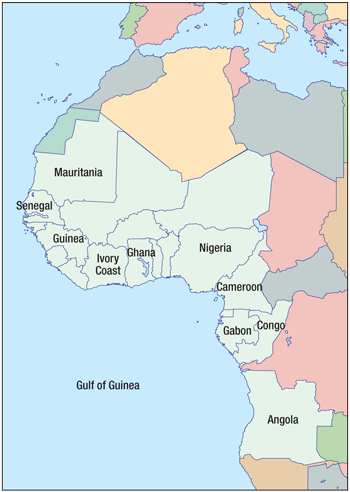
|
|
Fig. 1. In terms of oil and gas activity, West Africa extends from Mauritania to Angola. Recent projects are concentrated in the Gulf of Guinea.
|
|
OPERATING ENVIRONMENT
West Africa has been the operating arena primarily for the major international oil companies (IOCs) such as ExxonMobil, Total, Eni, Shell, Chevron and BP due to heavy upfront financial commitments for acquiring the lease concessions as well as to fund the mega-projects over the life of the fields. Steadily, the national oil companies (NOCs) are getting involved as operators. For example, Sonangol is the operator for Gimboa Field in Angola with Statoil as the technology partner. A few independents have been able to squeeze into West Africa as minority partners and even operators. In Ghana, where the IOCs missed major exploration plays and concession terms are favorable, Anadarko and small independents, such as Tullow Oil and Kosmos Energy, have made giant discoveries and are operating the fields. Operators from China and India are also beginning to make an impact in West Africa. In July, Sinopec struck oil with its first exploration well drilled in Nigeria’s Block 137, which it acquired after purchasing Swiss company Addax Petroleum. CNOOC owns 45% of OML Block 130, which includes Akpo, Egina and Preowei Fields. India’s ONGC Mittal is drilling an exploration well in Nigerian OPL Block 285 after acquiring 64.5% ownership in the block.
END TO GAS FLARING
One of the environmental issues associated with West Africa has been the flaring of natural gas, as most operators found it more lucrative to produce oil exclusively. Since 2000, Shell and its partners have undertaken associated gas gathering projects to reduce flaring by 75% by late 2009, Fig. 2. The Nigerian Senate has imposed a Dec. 31, 2010, deadline to stop gas flaring. As a result, many operators are reinjecting the produced gas, along with produced water, to maintain reservoir pressure. In addition, gas export pipelines and LNG projects have recently been built or are in planning and construction phases to manage the gas production. Among these projects is the West African Gas Pipeline (WAGP), which will transport Nigeria’s gas to the neighboring countries of Benin, Togo and Ghana to generate electricity. Shell and its partners will supply half of the initially required gas, an estimated 65–70 MMcfd, when commercial operations begin later in 2010.
|
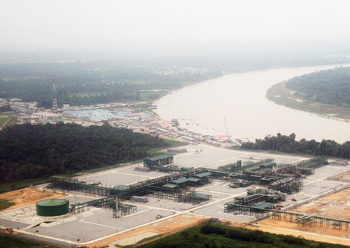
|
|
Fig. 2. Aerial photo of Shell Nigeria’s central processing facility of the Gbaran Ubie integrated oil and gas project in southern Niger Delta during the final stages of the construction.
|
|
Here’s a country-by-country report of current and upcoming operator activity in West Africa.
NIGERIA
Once Africa’s leading oil producer, Nigeria lost its premier spot to Angola as production dropped from 2.2 million bpd in 2008 to 1.8 million bpd in 2009. The continuous drop in production since 2005 is the result of rebel unrest in the Niger Delta and apprehension over a contentious Petroleum Industry Bill (PIB). A key provision in the PIB is increased government take, particularly for deepwater production sharing contracts. IOCs have delayed investment decisions on upcoming projects due to these concerns and are increasingly transferring their resources to adjacent hot spots such as Angola, Ghana and Congo.
The Nigerian National Petroleum Company (NNPC) is the country’s NOC, active in both upstream and downstream sectors. To support local activity, operators and service companies have established extensive construction yards and service facilities in the region, Fig. 3.
|
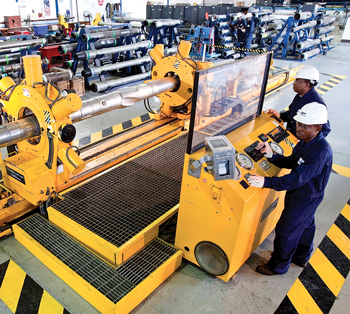
|
|
Fig. 3. Baker Hughes began full operations in February 2010 of its 463,000-sq-ft completions and production facility near Port Harcourt, Nigeria.
|
|
Gbaran-Ubie. This onshore Shell project in the Niger Delta is currently producing oil and gas, but is expected to be fully operational in 2011, producing 1 Bcfd of gas and 70,000 bpd of condensates. The project gathers oil and gas production from 33 wells in five fields spread over a 650-sq-mi area of Bayelsa and Rivers states. Most of the gas will be transported to the Nigeria LNG plant in Bonny to support existing export contracts.
Agbami. Operated by Chevron, Agbami is the largest deepwater field in Nigeria, with a plateau production rate of 250,000 boepd
achieved in August 2009. The field is located 70 mi off the Nigerian coast at a water depth of 4,800 ft and has been developed with 32 subsea wells connected to an FPSO. As part of this subsea development, FMC manufactured 12 four-slot manifolds and suction piles in Nigeria. In December 2009, Chevron began a 10-well development program to offset the field decline. First production from this enhanced recovery program is expected in 2011. Chevron’s partners in the field are Statoil (35%), NNPC (15%) and Petrobras (5%).
Akpo. Located 124 mi offshore Nigeria in water depths of 4,265–4,921 ft, Akpo Field was brought onstream by Total in June 2009 after its discovery in 2002. Primarily a condensate and natural gas field, Akpo’s proved and probable reserves are estimated at 620 million bbl of condensate and more than 989 Bcf of gas. The plateau production from the field consists of 175,000 bpd of condensate and, 318 MMcfd of produced gas exported to the Nigeria LNG liquefaction plant, and an additional 177 MMcfd of gas is reinjected into the reservoir. Akpo’s subsea architecture consists of 22 producers, 20 water injectors and two gas injectors. The subsea network consists of over 100 km of flowlines, 80 km of umbilicals and 14 risers tying the production into the FPSO. The 310-m-long, 61-m-wide and 31-m-high FPSO is designed to process 185,000 bcpd and 530 MMcfd and to store up to 2 million bbl of condensate.
Oyo. Eni started production from Oyo Field in 2009 at an initial production rate of 25,000 bpd. The field is located 47 mi off the Niger Delta coast in 1,312-ft water depth. The Oyo production from two subsea wells is connected to the Armada Perdana FPSO, which has a treatment capacity of 40,000 bpd. The associated gas is reinjected into the reservoir through a third well.
Usan. Located 62 mi offshore in the eastern Niger Delta region in 2,461 ft of water, Usan Field was discovered in 2002 and began development in 2008 with Total as the operator. Development drilling commenced in June 2009, and production startup is projected for 2012. Maximum total production of 180 million bpd is expected by 2013 from 23 production wells. The development will also have 19 water and gas injection wells. Hyunday Heavy Industries will deliver the 1,050-ft FPSO in late 2011. Cameron was awarded the contract for the 44-well subsea development.
Aparo and Bonga SW. These two fields share a common geologic structure and will be developed simultaneously. The structure is located 70 mi off the western Niger Delta coast at 4,300-ft water depth. The project was delayed in 2009 to secure agreement among the stakeholders on the scope and commercial terms of the project.
Nsiko. Chevron’s latest deepwater project is Nsiko Field, located 90 mi offshore the western Niger Delta at 5,800-ft water depth. Subsurface evaluations and field development planning were completed in 2008. Development activities and FEED will begin upon negotiation of the commercial terms.
ANGOLA
Angola has experienced significant total liquids production growth over the last decade from 750,000 bpd in 1999 to 2.1 million bpd in 2009. That year, Angola actually produced more crude oil than Nigeria (1.82 million bpd compared to 1.80 million bpd). Foreign investment for new projects is continuing to flow into Angola at the expense of Nigeria, Fig. 4. However, even Angola is not without security issues; onshore development in the oil-rich Cabinda province has been halted due to violence in the region. Angola’s current oil exports of 1.7 million bpd go primarily to China and the US. On Aug. 10, officials from state company Sonangol, Total, Statoil, Esso and BP gathered on the Girassol platform to commemorate the milestone billionth barrel of oil produced since the start of production 10 years ago in Block 17.
|
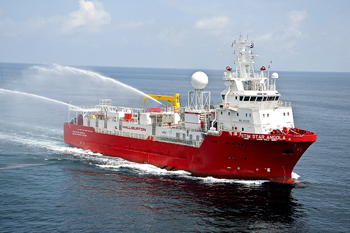
|
|
Fig. 4. In June 2009, Halliburton deployed its second-generation stimulation vessel Stim Star Angola, with DP2 dynamic positioning capability, to support production operations in the region.
|
|
Seismic data. Sonangol has granted WesternGeco rights to acquire new 3D multiclient surveys in the Kwanza Basin, offshore Angola, commencing later in 2010. One of the surveys will cover 2,600 sq mi of Blocks 19 and 20. The objective is to merge the new data with adjacent 3D depth data to create a seamless depth merge across the basin. WesternGeco is also working, in association with Sonangol, on a 3D prestack anisotropic depth merge project of the Kwanza Basin. Additionally, a WesternGeco Q-Seabed multicomponent seismic crew recently completed a year-long 3D ocean-bottom cable (OBC) acquisition project offshore Angola. The 420-sq-mi survey was acquired over a highly congested, active oil field with many platforms, installations, pipelines and single-point mooring systems. In late 2009, WesternGeco also completed the first wide-azimuth (WAZ) survey in Angolan waters.
Kizomba. Production from Kizomba A, B, C and North have made ExxonMobil’s local company, Esso Angola, the country’s leading oil producer. Kizomba A and B produce from four discoveries announced in 1998: Hungo, Chocalho, Kissanje and Dikanza. The deepwater projects are about 90 mi offshore in 3,900 ft of water. Kizomba A came onstream in 2004, Kizomba B in 2005, Kizomba North in 2007 and Kizomba C in 2008. The Marimba North project incorporates a subsea connection to the FPSO at Kizomba A.
The Kizomba B project required the world’s largest FPSO. Fields contributing to Kizomba C are Mondo, Saxi and Batuque through 36 subsea wells.
To speed development, as many as six rigs have operated simultaneously on the different fields in the block. Two of these rigs were the Kizomba A and Kizomba B tension-leg platforms (TLPs), and the remaining rigs were MODUs working on a drilling schedule of more than 100 subsea wells distributed amid 18 subsea drill centers. Production from the block was at its peak in 2008 at the rate of 700,000 bpd.
Pazlor. Among the new projects scheduled to come onstream is Total’s Pazlor project in Block 17, which will develop production from the Perpetua, Acacia, Zinia and Hortensia discoveries. First oil is expected in 2011 at the initial rate of 220,000 bpd. Located in the Gulf of Guinea 93 mi off the coast, the four reservoirs are scattered over an area of 600 sq mi at a water depth of about 4,000 ft. Acacia contains light oil, whereas the other three are Miocene reservoirs characterized by heavy, viscous oil.
Total plans to use subsea oil-water separators for the heavy oil reservoir. The separated oil and water will be pumped to the FPSO using ESPs. Total has built an FPSO capable of processing 220,000 bpd of oil and with storage capacity of 1.9 million bbl, Fig. 5. The produced water will be reinjected into the reservoirs. The two subsea production systems encompass 49 wells (25 producers, 22 water injectors and two gas injectors) and three subsea separation units connected to six ESPs. The topsides control system is designed to accommodate 21 additional wells and a fourth subsea separation unit.
|
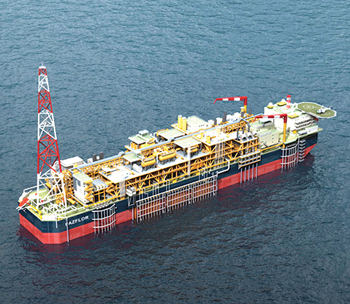
|
|
Fig. 5. Total’s Pazlor FPSO is capable of processing 220,000 bpd of oil and has a storage capacity of 1.9 million bbl.
|
|
CLOV. The latest project in Block 17 will gather production from four discoveries: Cravo, Lirio, Orchidea and Violet (CLOV). Total has received approval from its partners to begin drilling in 2012 so as to achieve first oil in 2014. The subsea development will consist of 34 wells tied back to an FPSO with a processing capacity of 160,000 bpd at plateau and storage capacity of 1.78 million bbl. The FPSO will be able to process two types of crude oil, light oil from Oligocene reservoirs and heavier oil from Miocene reservoirs. Both oil streams would be combined aboard the FPSO in a single train prior to storage.
Gimboa. Located on Block 4/05, Gimboa Field is being developed by Sonangol, a first for the national oil company as the operator. The field is 53 mi from the Angolan coast in 2,300 ft of water. The development centers around three production wells and four water injection wells tied back to an FPSO. The average production has been 21,000 bpd since first oil in April 2009. Engineering design is underway for Phase 2 development of discoveries UMC-6 and UMC-7.
Tombua Landana. Operated by Chevron in Block 14, Tombua Landana is a 46-well project located 50 mi off Angola in 1,200 ft of water. Tombua and Landana Fields were discovered in 1997 and 2001, respectively. The development started with the Landana North reservoir in 2006 and continued in 2006–2007 with pre-drilling of the central reservoirs. In late 2008, Chevron installed a compliant piled tower (CPT) to support a drilling and production platform (DPP). At 1,554 ft, the CPT is one of the tallest manmade structures in the world. Production started in 2009 and is expected to reach 100,000 bpd by 2011. High levels of barium in the produced water require treatment before reinjection in order to prevent barium sulfate scale in the wellbore and production equipment. Surplus gas will be exported to Block 0 via a pipeline that ties into a gas export pipeline. The gas will be stored in an existing reservoir until it can be commercialized through the Angola LNG project.
PSVM. In Block 31, the BP-operated PSVM project is a hub field development designed to produce from Plutao, Saturno, Venus and Marte oil fields, which were discovered during 2002–2004. The subsea construction consists of 40 production and both water and gas injection wells connected through 14 manifolds, flowlines and umbilicals to an FPSO. First oil is expected in September 2011, building to a plateau of about 150,000 bpd by 2012.
Gas export. Operators on Block 17 are developing a gas export project for delivery of associated gas to Sonangol. During Phase 1, an export line is being constructed from Block 17 to Block 2 for gas reinjection into a wellhead platform if an LNG terminal is not available. During Phase 2, an export line will be constructed from Block 2 to an onshore LNG plant.
GHANA
Ghana has been producing only 7,000 bpd of oil for the last three years, but it has a bright future as a result of the discovery of the giant Jubilee Field in the West Cape Three Points Block. Smaller independents have found it easier to operate in Ghana as result of highly lucrative production sharing contract terms. Ghana requires no front-end payments, and has negotiable royalties and an income tax rate of 35%, no restriction on repatriation of income and no import duties on oilfield equipment and materials.
Jubilee. Discovered in 2007, Jubilee Field is in Phase 1 of development with first oil expected in December 2010, Fig. 6. Tullow Oil is the field operator with partners Kosmos Energy and Anadarko providing technical expertise. Ghana National Petroleum Corporation (GNPC) holds 10%. An FPSO will be used to produce light oil from the field via nine producing wells, delivering a plateau oil rate of 120,000 bpd expected within six months. Nine water and three gas injection wells will be used to maintain pressure. The estimated P90 recoverable reserves of the field are at 600 million, with an ultimate potential of 1.8 billion bbl. In July, the Ghanaian government rejected Kosmos’ proposal to sell its 30.8% stake in Jubilee Field to ExxonMobil. According to news reports, a joint CNOOC and GNPC acquisition is pending.
|
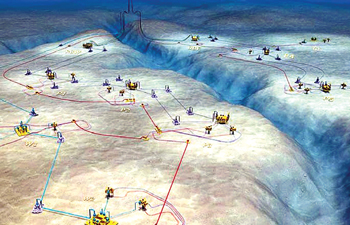
|
|
Fig. 6. For Phase 1 of the Jubilee project in Ghana, FMC will construct a subsea network of nine producing wells, nine water injectors and three gas injection wells to produce 120,000 bpd of crude oil.
|
|
Tweneboa, Odum and Mahogany Deep. Several major fields in West Cape Three Points and Tano Blocks are undergoing various phases of exploration and appraisal. Tweneboa, Odum and Mahogany Deep Fields will keep Anadarko, Tullow and Kosmos active for several decades to come.
EQUATORIAL GUINEA
Equitorial Guinea became an oil producer with ExxonMobil’s 1995 discovery of Zaffiro Field. By 2005, production increased to 375 million bpd. Since then, production decline has reduced the output in 2009 to 346,000 bpd. The oil production comes from Zafiro, Ceiba and Okume Fields, while Alba Field delivers condensates. New field developments are underway, but no additional production is expected before 2012.
Equatorial Guinea began LNG production in 1997 with wet gas from Alba Field. In 2007, Marathon Oil and its partners completed Train 1 of its Punta Europa LNG facility on Bioko Island. The train is capable of processing 3 Tcf of gas from Alba Field. A second train is being planned to accept gas from Zafiro Field and stranded gas from Cameroon and Nigeria.
CONGO
The Republic of Congo, with Brazzaville as its capital, produced 275,000 bpd of crude oil and liquids in 2009 after reaching the peak of 300,000 bpd in 2008. Much of the production comes from fields operated by Total and Agip. One of the newer fields in Congo is Azurite, located in 4,600 ft of water about 80 mi offshore. The field was discovered in 2005 and produced its first oil in August 2009. Operator Murphy Oil is using a 10-tree subsea drill center producing 15,000 bpd back to a floating drilling, production, storage and offloading (FDPSO) vessel. Murphy made news in July when it relocated Diamond Offshore’s Ocean Confidence semisubmersible to Congo after it was idled by the deepwater moratorium in the Gulf of Mexico.
GABON
Gabon’s total oil production in 2009 was 242,000 bpd after reaching a peak of 370,000 bpd in 1997. Gabon’s largest fields are Shell-operated Rabi-Kuonga and Gamba-Irvinga Fields. Houston-based independent operator Vaalco Energy is producing oil from its Etame, Avouma, South Tchibaba and Ebouri Fields with its Petroleo Nautipa FPSO at the rate of 25,000 bpd. Total is currently in Phase 2 of its Anguille Field redevelopment through the drilling of 30 wells. Production from the field, discovered in 1962, is expected to plateau at 30,000 bpd in 2013–2014.
CAMEROON
Cameroon produced 77,000 bpd in 2009 after peaking at 370,000 bpd in 1985. Production from land-locked Chad is exported through the Chad-Cameroon pipeline. While Chad’s production has been climbing, Cameroon has suffered a steady decline due to aging fields. On the other hand, Cameroon has substantial gas reserves. In 2007, the national oil companies of Cameroon and Equatorial Guinea announced an agreement to develop an LNG export plant in Cameroon. Bowleven, an independent operator based in Edinburgh, Scotland, is currently conducting exploration drilling in the country.
MAURITANIA
Oil production began in Mauritania in 2004 and has declined to 16,500 bpd in 2009 after achieving 30,600 bpd in 2006. Australia-based Woodside Petroleum developed Chinguetti Field in 2006, but the offshore field has suffered significant production decline. In 2007, Woodside sold its Mauritania assets to Petronas.
FUTURE DEVELOPMENT
West Africa has excellent exploration opportunities that can continue to keep the region active as the world’s leading oil factory. In addition, the mandate to eliminate natural gas flaring will provide opportunities for LNG facilities to feed the export market as well as for pipeline and processing facilities to support the region’s commercial and residential gas and electric power needs. Meanwhile, the region will face increased pressure to improve safety and spill containment infrastructure in the aftermath of the US Gulf of Mexico spill.
The oil and gas industry may also continue to suffer disruptions and losses caused by unrest and violence that have plagued Nigeria. Most of the IOCs in the region have instituted community programs to add local content in terms of jobs, training and supply chain contracts. There are also programs to improve health facilities and control the spread of HIV. If such programs succeed, there will be greater stability and increased investment in energy projects. 
.
|








